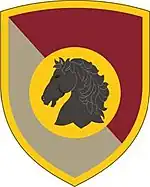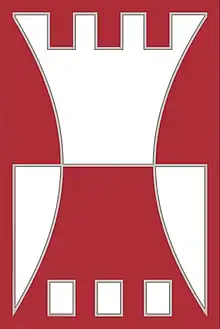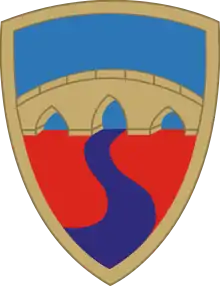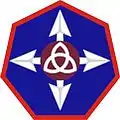79th Infantry Division (United States)
The 79th Infantry Division (formerly known as the 79th Division) was an infantry formation of the United States Army Reserve in World Wars I and II.
| 79th Infantry Division 79th Division | |
|---|---|
 79th Infantry Division Shoulder Sleeve Insignia | |
| Active |
|
| Country | |
| Branch | |
| Type | Infantry |
| Size | Division |
| Part of | |
| Nickname(s) | "Cross of Lorraine" (special designation)[1] |
| Engagements | World War I |
| Commanders | |
| Notable commanders | Ira T. Wyche Anthony McAuliffe |
Since 2009, it has been active as the 79th Theater Sustainment Command.
World War I
- Activated: August 1917
- Overseas: July 1918
- Major operations: Meuse-Argonne
- Casualties: Total-6,874 (KIA-1,151 ; WIA-5,723)
- Commanders: Maj. Gen. Joseph E. Kuhn (25 August 1917), Brig. Gen. William Jones Nicholson (26 November 1917), Maj. Gen. Joseph E. Kuhn (17 February 1918), Maj. Gen. Joseph E. Kuhn (16 April 1918), Brig. Gen. W. J. Nicholson (22 May 1918), Maj. Gen. Joseph E. Kuhn (8 June 1918), Brig. Gen. W. J. Nicholson (28 June 1918), Maj. Gen. Joseph E. Kuhn (23 July 1918), Brig. Gen. Evan M. Johnson (29 December 1918), Maj. Gen. Joseph E. Kuhn (31 December 1918), Brig. Gen. Evan M. Johnson (19 January 1919), Brig. Gen. John S. Winn (2 February 1919), Brig. Gen. Andrew Hero Jr. (3 February 1919), Brig. Gen. Evan M. Johnson (9 February 1919), Maj. Gen. Joseph E. Kuhn (28 February 1919), brig. Gen. Evan M. Johnson (16 March 1919), Maj. Gen. Joseph E. Kuhn (30 March 1919), Brig. Gen. Joseph S. Winn (4 May 1919), Maj. Gen. Joseph E. Kuhn (8 May 1919).
- Returned to U.S.: May 1919
- Inactivated: June 1919
Order of battle
- Headquarters, 79th Division
- 157th Infantry Brigade
- 313th Infantry Regiment
- 314th Infantry Regiment
- 311th Machine Gun Battalion
- 158th Infantry Brigade
- 315th Infantry Regiment
- 316th Infantry Regiment
- 312th Machine Gun Battalion
- 154th Field Artillery Brigade
- 310th Field Artillery Regiment (75 mm)
- 311th Field Artillery Regiment (75 mm)
- 312th Field Artillery Regiment (155 mm)
- 304th Trench Mortar Battery
- 310th Machine Gun Battalion
- 304th Engineer Regiment
- 304th Field Signal Battalion
- Headquarters Troop, 79th Division
- 304th Train Headquarters and Military Police
- 304th Ammunition Train
- 304th Supply Train
- 304th Engineer Train
- 304th Sanitary Train
- 313th, 314th, 315th, and 316th Ambulance Companies and Field Hospitals
Combat chronicle
The division was first activated at Camp Meade, Maryland in August 1917, composed primarily of draftees from Maryland and Pennsylvania. After a year of training the division sailed overseas in July 1918. The 79th Division saw extensive combat in the Meuse-Argonne Offensive area where it earned the name of "Cross of Lorraine" for their defense of France. The division was inactivated June 1919 and returned to the United States.
Throughout its entire World War I campaign, the division suffered 6,874 casualties with 1,151 killed and 5,723 wounded. Private Henry Gunther, the last American soldier to be killed in action during World War I, served with the 313th Infantry Regiment of the 79th Division.
Interwar period
The division was reconstituted in the Organized Reserve on 24 June 1921 and assigned to the eastern half of the state of Pennsylvania. The headquarters was organized on 29 September 1921. It formed part of the XIII Corps (United States), Third Corps Area.[2]
World War II
- Ordered into active military service: 15 June 1942 at Camp Pickett, Virginia
- Trained at Camp Laguna in California in 1943.
- Overseas: 7 April 1944
- Campaigns: Normandy, Northern France, Rhineland, Ardennes-Alsace, Central Europe
- Days of combat: 248
- Distinguished Unit Citations: 8
- Awards: Medal of Honor-3 ; Distinguished Service Cross (United States)-13 ; Distinguished Service Medal (United States)-1 ; Silver Star-962; Legion of Merit-11 ; Soldier's Medal-27 ; Bronze Star-4,916 ; Air Medal-78
- Commanders: Major General Ira T. Wyche (June 1942 – May 1945), Brigadier General Leroy H. Watson (May–July 1945), Major General Anthony C. McAuliffe (July–August 1945), Brigadier General Leroy H. Watson (August 1945 to inactivation).
- Returned to U.S.: 10 December 1945.
- Inactivated: 20 December 1945, Camp Kilmer, New Jersey.
- Reactivated: (Organized Reserve division 29 November 1946).
Order of battle
- Headquarters, 79th Infantry Division
- 313th Infantry Regiment
- 314th Infantry Regiment
- 315th Infantry Regiment
- Headquarters and Headquarters Battery, 79th Infantry Division Artillery
- 310th Field Artillery Battalion (105 mm)
- 311th Field Artillery Battalion (105 mm)
- 312th Field Artillery Battalion (155 mm)
- 904th Field Artillery Battalion (105 mm)
- 304th Engineer Combat Battalion
- 304th Medical Battalion
- 79th Cavalry Reconnaissance Troop (Mechanized)
- Headquarters, Special Troops, 79th Infantry Division
- Headquarters Company, 79th Infantry Division
- 779th Ordnance Light Maintenance Company
- 79th Quartermaster Company
- 79th Signal Company
- Military Police Platoon
- Band
- 79th Counterintelligence Corps Detachment
Combat chronicle
The division was activated at Camp Pickett, Virginia on 15 June 1942. It participated in the Tennessee Maneuver Area, after which it moved to Camp Laguna near Yuma, Arizona, where it trained in the desert. It was then ordered to Camp Phillips, Kansas for training in winter conditions. At the beginning of April 1944, the division reported to the port of embarkation at Camp Myles Standish, Massachusetts.

The division arrived in Liverpool on 17 April and began training in amphibious operations. After training in the United Kingdom from 17 April 1944, the 79th Infantry Division landed on Utah Beach, Normandy, 12–14 June and entered combat 19 June 1944, with an attack on the high ground west and northwest of Valognes and high ground south of Cherbourg Naval Base. The division took Fort du Roule after a heavy engagement and entered Cherbourg, 25 June. It was around this time that Corporal John D. Kelly and First Lieutenant Carlos C. Ogden, both of the 314th Infantry Regiment, were awarded the Medal of Honor.[3] It held a defensive line at the Ollonde River until 2 July 1944 and then returned to the offensive, taking La Haye du Puits in house-to-house fighting, 8 July. On 26 July, the 79th attacked across the Ay River, took Lessay, crossed the Sarthe River and entered Le Mans, 8 August, meeting only light resistance. The advance continued across the Seine, 19 August. Heavy German counterattacks were repelled, 22–27 August, and the division reached the Therain River, 31 August. Moving swiftly to the Franco-Belgian frontier near St. Amand (east of Lille), the division was then moved to XV Corps in eastern France, where it encountered heavy resistance in taking Charmes in street fighting, 12 September. The 79th cut across the Moselle and Meurthe Rivers, 13–23 September, cleared the Forêt de Parroy in a severe engagement, 28 September – 9 October, and attacked to gain high ground east of Emberménil, 14–23 October, when it was relieved, 24 October.
After rest and training at Lunéville, the division returned to combat with an attack from the MignevineMontiguy area, 13 November 1944, which carried it across the Vezouse and Moder Rivers, 18 November – 10 December, through Haguenau in spite of determined enemy resistance, and into the Siegfried Line, 17–20 December. The division held a defensive line along the Lauter River, at Wissembourg from 20 December 1944 until 2 January 1945, when it withdrew to Maginot Line defenses. The German attempt to establish a bridgehead west of the Rhine at Gambsheim resulted in furious fighting. The 79th beat off German attacks at Hatten and Rittershoffen in an 11-day battle before withdrawing to new defensive positions south of Haguenau on the Moder River, 19 January 1945. The division remained on the defensive along the Moder until 6 February 1945. During February and March 1945, the division mopped up German resistance, returned to offensive combat, 24 March 1945, crossed the Rhine, drove across the Rhine-Herne Canal, 7 April, secured the north bank of the Ruhr and took part in clearing the Ruhr Pocket until 13 April. The division then went on occupation duty, in the Dortmund, Sudetenland, and Bavarian areas successively, until its return to the United States and inactivation.
Casualties
Assignments in European Theater of Operations
- 18 April 1944: VIII Corps, Third Army.
- 29 May 1944: Third Army but attached to VII Corps, First Army.
- 30 June 1944: Third Army, but attached to First Army.
- 1 July 1944: VIII Corps.
- 1 August 1944: VIII Corps, Third Army, 12th Army Group.
- 8 August 1944: XV Corps.
- 24 August 1944: XV Corps, Third Army, 12th Army Group, but attached to First Army.
- 26 August 1944: XV Corps, First Army, 12th Army Group.
- 29 August 1944: XII Corps.
- 7 September 1944: XV Corps, Third Army, 12th Army Group.
- 29 September 1944: Third Army, 12th Army Group, but attached to the XV Corps, Seventh Army, 6th Army Group.
- 25 November 1944: XV Corps, Seventh Army, 6th Army Group.
- 5 December 1944: VI Corps.
- 6 February 1945: Seventh Army, 6th Army Group.
- 17 February 1945: Seventh Army, 6th Army Group, but attached to the XVI Corps, Ninth Army, 12th Army Group.
- 1 March 1945: XIII Corps.
- 7 March 1945: XVI Corps.
- 7 April 1945: XVI Corps, Ninth Army, 12th Army Group.
79th Sustainment Support Command
The 79th Infantry Division is now the 79th Sustainment Support Command (SSC) headquartered at Joint Forces Training Base (JFTB) Los Alamitos, California. The 79th SSC was officially activated on 1 December 2009 with the mission of providing trained, ready, cohesive, well-led sustainment units for worldwide deployment to meet the U.S. Army's rotational and contingency mission requirements in support of the National Military Strategy. The 79th SSC is the higher headquarters of over 20,000 U.S. Army Reserve sustainment soldiers organized into over 200 units dispersed throughout the western half of the United States. Major subordinate commands of the 79th SSC include the 4th Sustainment Command (Expeditionary) in San Antonio, Texas, the 311th Sustainment Command (Expeditionary) in Los Angeles, California, the 364th Sustainment Command (Expeditionary) in Marysville, Washington, and the 451st Expeditionary Sustainment Command in Wichita, Kansas. As the operational command posts of a theater sustainment command – the ESCs plan, coordinate synchronize, monitor, and control operational- level sustainment operations for Army service component commands, joint task forces and joint forces commands throughout the world.
- Reactivated: 1 December 2009
- Commanders
- Major General William D. Frink, Jr. (1 December 2009 – 8 February 2013)
- Major General Megan P. Tatu (9 February 2013 – 4 December 2015)
- Major General Mark Palzer (5 December 2015 – 8 December 2018)
- Major General Eugene J. Leboeuf (8 December 2018 – Present)
Subordinate units
As of 2020 the following units are subordinated to the 79th Theater Sustainment Command:[5]
- 79th Theater Sustainment Command, in Los Alamitos, California
 4th Sustainment Command (Expeditionary), at Fort Sam Houston, Texas[6]
4th Sustainment Command (Expeditionary), at Fort Sam Houston, Texas[6]
 90th Sustainment Brigade, in Little Rock, Arkansas
90th Sustainment Brigade, in Little Rock, Arkansas
- 316th Support Battalion (Petrol), in Okmulgee, Oklahoma
- 348th Transportation Battalion (TML), in Houston, Texas
 300th Sustainment Brigade, in Grand Prairie, Texas
300th Sustainment Brigade, in Grand Prairie, Texas
- 363d Support Battalion (PETRL PL & TML OP), in San Marcos, Texas
- 211th Regional Support Group, in Corpus Christi, Texas
- 319th Combat Sustainment Support Battalion, in Harlingen, Texas
- 373d Combat Sustainment Support Battalion, in Beaumont, Texas
 647th Regional Support Group, in El Paso, Texas
647th Regional Support Group, in El Paso, Texas
- 372d Quartermaster Battalion (Petroleum Support) in Kirtland Air Force Base, Albuquerque, New Mexico[7]
- 383d Support Battalion (PETRL PL & TML), in El Paso, Texas
.jpg.webp) 311th Sustainment Command (Expeditionary), in West Los Angeles, California
311th Sustainment Command (Expeditionary), in West Los Angeles, California
 304th Sustainment Brigade, in Riverside, California
304th Sustainment Brigade, in Riverside, California
- 155th Combat Sustainment Support Battalion, in South El Monte, California
- 371st Combat Sustainment Support Battalion, in Riverside, California
- 420th Support Battalion (MVT CTL) (EAC), in Sherman Oaks, California
- 326th Finance Group, in West Los Angeles, California
 364th Sustainment Command (Expeditionary), in Marysville, Washington
364th Sustainment Command (Expeditionary), in Marysville, Washington
- 650th Regional Support Group, in North Las Vegas, Nevada
- 314th Combat Sustainment Support Battalion, in Las Vegas, Nevada
- 469th Combat Sustainment Support Battalion, in Mountain View, California
- 483d Transportation Battalion, in Vallejo, California
- 653rd Regional Support Group, in Mesa, Arizona
- 336th Combat Sustainment Support Battalion, in Buckeye, Arizona
- 418th Quartermaster Battalion (Petroleum Support) in Marana, Arizona[7]
- 419th Combat Sustainment Support Battalion, in Tustin, California
- 650th Regional Support Group, in North Las Vegas, Nevada
 451st Sustainment Command (Expeditionary), in Wichita, Kansas
451st Sustainment Command (Expeditionary), in Wichita, Kansas
 89th Sustainment Brigade, in Kansas City, Missouri
89th Sustainment Brigade, in Kansas City, Missouri
- 329th Combat Sustainment Support Battalion, in Parsons, Kansas
- 484th Transportation Battalion, in Springfield, Missouri
- 620th Combat Sustainment Support Battalion, in St. Louis, Missouri
- 561st Regional Support Group, in Elkhorn, Nebraska
- 394th Combat Sustainment Support Battalion, in Fremont, Nebraska
- 425th Transportation Battalion, in Salina, Kansas
- 450th Transportation Battalion, in Manhattan, Kansas
General
- Nickname: Cross of Lorraine Division.
- Shoulder patch: White bordered blue shield on which is superimposed a cross of Lorraine.
In popular culture
- The HBO period drama Perry Mason depicts the titular character as a Captain who served in the 79th Infantry during World War I before receiving a blue discharge. The second episode depicts a flashback with Mason participating in the Meuse–Argonne offensive of 1918.
See also
- Rhino tank
- Royal C. Johnson, who served with the division during World War I
- Thomas W. Miller, who also served with the 79th Division in World War I
- Val A. Browning
Notes
![]() This article incorporates public domain material from The Army Almanac: A Book of Facts Concerning the Army of the United States U.S. Government Printing Office, 1950. United States Army Center of Military History.
This article incorporates public domain material from The Army Almanac: A Book of Facts Concerning the Army of the United States U.S. Government Printing Office, 1950. United States Army Center of Military History.
References
- "Special Unit Designations". United States Army Center of Military History. 21 April 2010. Archived from the original on 9 July 2010. Retrieved 9 July 2010.
- Clay 2010, p. 247.
- "The Normandy Invasion: Medal of Honor Recipients". history.army.mil. Archived from the original on 11 June 2008.
- Army Battle Casualties and Nonbattle Deaths, Final Report (Statistical and Accounting Branch, Office of the Adjutant General, 1 June 1953)
- "79th TSC". www.usar.army.mil. Retrieved 4 September 2020.
- "U.S. Army Reserve > Commands > Functional > 79th TSC > 4th ESC > 4thESCUnits". www.usar.army.mil. Retrieved 4 September 2020.
- "U.S. Army Reserve > Commands > Functional > 377th TSC > 4th ESC > 4thESCUnits".
6. The Cross of Lorraine: A Combat History of the 79th Infantry Division, June 1942-December 1945. Army and Navy Publishing Co., 1946. [Official Division history]
Sources
- Clay, Steven E. (2010). US Army Order of Battle 1919–1941, Vol. 1: The Arms: Major Commands and Infantry Organizations (PDF). Fort Leavenworth, Kansas: Combat Studies Institute Press.
 This article incorporates text from this source, which is in the public domain.
This article incorporates text from this source, which is in the public domain.
External links
- 79th Inf, Small World War II Photo Album
- Montfaucon: Captain Barber and the 313th Regiment at American Battle Monuments Commission
- The World War II Letters of Private Melvin W. Johnson of the 314th Infantry Regiment, 79th Division
- World War I diary of Harry Frieman, 313th Machine Gun Company, 79th Division, Harry Frieman Collection (AFC/2001/001/23600), Veterans History Project, American Folklife Center, Library of Congress.